Physical Address
304 North Cardinal St.
Dorchester Center, MA 02124
![]() Access video content for this chapter online at Elsevier eBooks+
Access video content for this chapter online at Elsevier eBooks+
The integrated approach for unilateral cleft lip repair ( ) is based on the senior author’s personal experience over a period of 33 years in a Taiwanese population. The surgical technique has been tested in other racially diverse populations. The approach is an ongoing process of refinements in presurgical management, surgical techniques, and postsurgical maintenance.
A multidisciplinary approach is essential to the total patient care of patients with cleft lip and palate ( ) from infancy to adulthood. This includes plastic surgeons, orthodontists, speech pathologists, pedodontists, otolaryngologists, clinical psychologists, and social workers. A clinical coordinator serves to coordinate all these specialties for the benefit of the patients as well as gathering vital information.
However, the involved specialties are different for different pathologies, and so is the burden of care for parents. For example, patients with only cleft lips do not need speech evaluation and, in most cases, neither is an orthodontic treatment required in their multidisciplinary approach. It is very important to give parents clear instructions on the timing of the necessary treatments at their first visit to reduce their anxiety during the subsequent pathway of care.
The patient is carefully examined by a plastic surgeon at the first visit. A plan for presurgical management is made after thorough physical examination. If the pathology involves lip, alveolus, and palate (e.g., complete cleft of primary and secondary palate), orthodontic consultation is needed for nasoalveolar molding, otherwise only nasal molding is performed by a plastic surgeon with silicone conformers.
Presurgical nasoalveolar molding (NAM, for complete cleft lip and palate) is started at the first visit.
The suggested benefits of NAM are: (1) improved feeding, (2) improved maxillary position, (3) narrowing of the alveolar cleft, (4) improved maxillary growth, (5) improved shape of the nose. However, most of these benefits are controversial in present literature reviews. The alveolar gap can be improved by lip taping and prone sleep position instead of purely by NAM. Feeding, body weight gain, and long-term facial growth do not have good correlation with NAM.
The senior author believes that the main purpose of NAM is to improve the shape of the nose, skin coverage, the shape of the lower lateral cartilage and the nasal lining on the cleft side, thus improving the result of nasal reconstruction and reducing the necessity of secondary surgery.
During the past 25 years, several different NAM techniques have been used for presurgical management by the orthodontists working with the senior author. Among these techniques, modified Grayson’s ( Fig. 19.2.1 ) and modified Figueroa’s techniques ( Fig. 19.2.2 ) are commonly use. Both molding techniques require outpatient adjustments every 1–2 weeks.
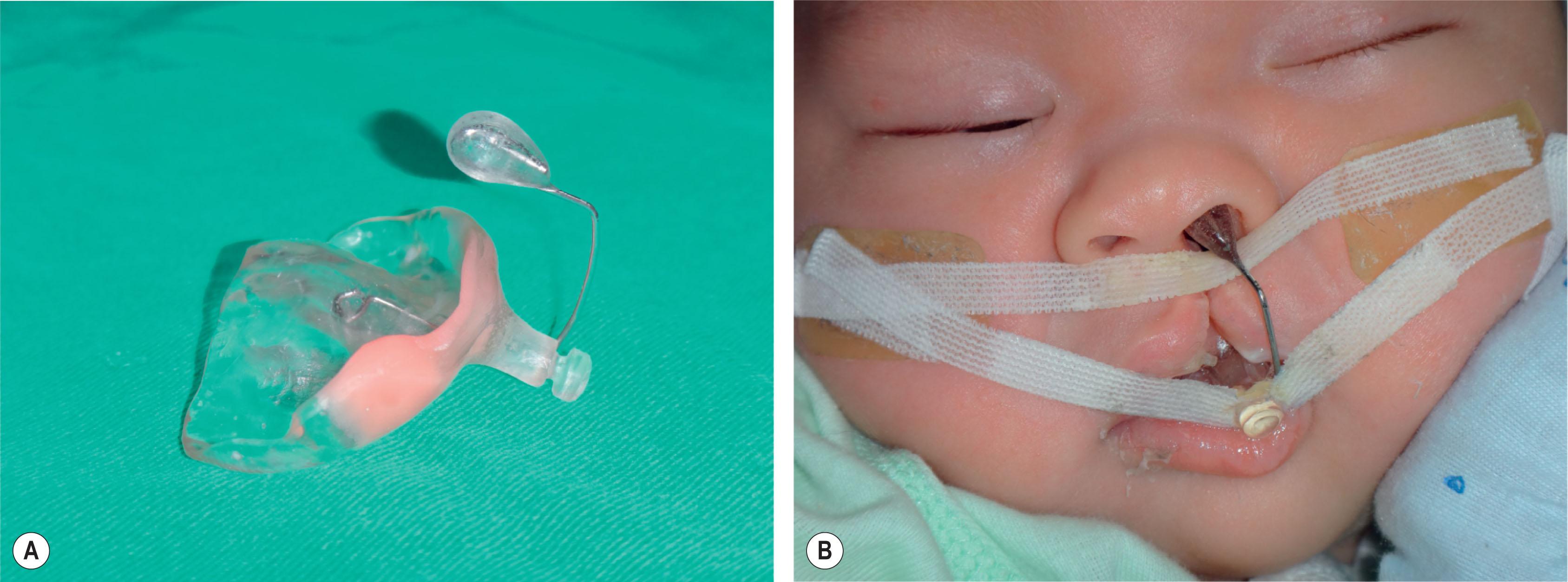
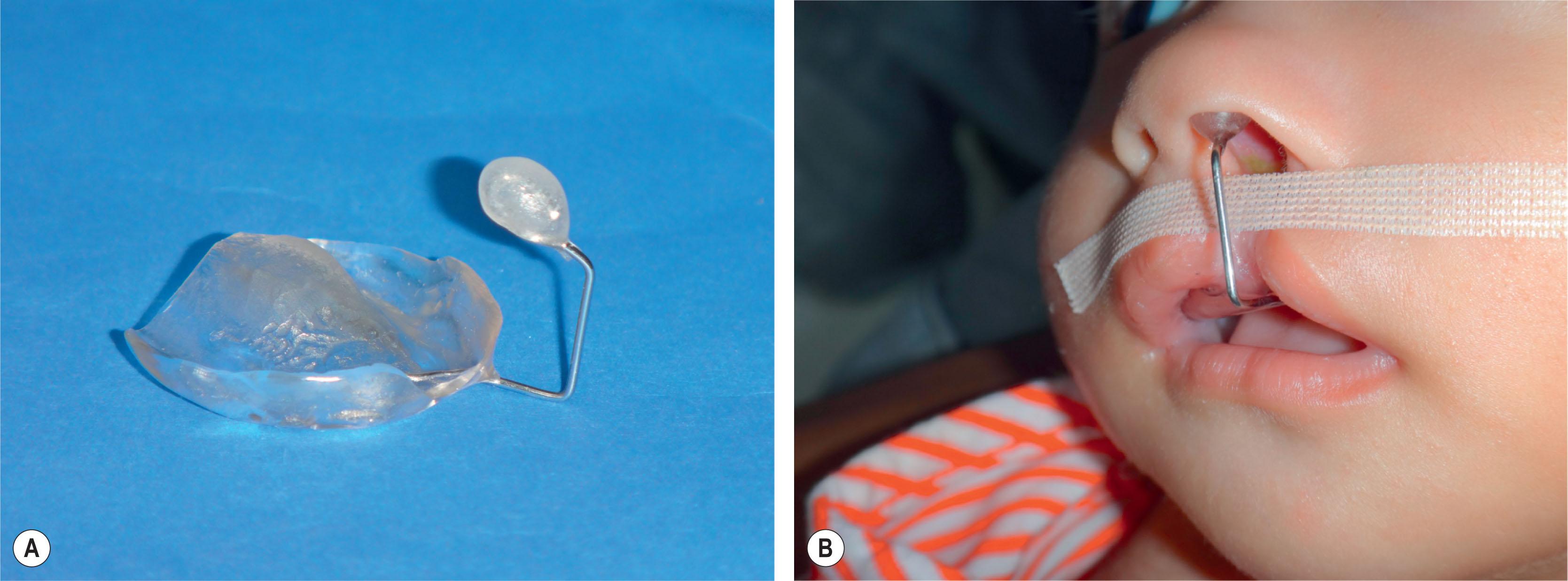
Both techniques use a palatal plate and nasal molding components. The difference between the two techniques is the sequence of the molding process. The modified Grayson’s technique starts with alveolar molding, and then nasal molding follows. The modified Figueroa’s technique consists of both alveolar molding and nasal molding carried out at the same time. Both techniques involve lip taping to narrow the alveolar cleft.
Both a retrospective review and a prospective randomized controlled trial showed no differences between these two NAM techniques in terms of frequency of clinical visits, total cost, nostril height and nostril area ratio. The modified Grayson technique reduced nostril width more efficiently but caused more alveolar ulceration. However, there was no difference in nostril width following surgery. Overall, these two NAM techniques produced similar nasal aesthetic outcomes.
Usually, it takes 3–4 months and 8–9 visits for the completion of the molding process. The burden of care through the whole NAM process has been criticized by many clinicians who do not use the technique. There are other kinds of devices that can improve the nasal shape without frequent clinical visits. These devices can be considered when NAM is not available or burden of care is not affordable by the parents.
As the senior author is used to repair the anterior palate at the time of the lip repair, a remaining alveolar gap of around 5 mm is preferred rather than a complete approximation of the alveolar segments through NAM.
For patients with incomplete cleft lip, nasal molding can be performed by using silicone nasal conformers. The senior author designed a set of asymmetric nasal conformers ( Fig. 19.2.3A ) with narrower width and different heights on the cleft side (No. 0 to No. 4, with 1 mm increment of height) that can gradually increase nasal dome height by stretching the columella as well as molding the shape of lower lateral cartilage on the affected side. Parents are instructed that the child should wear the conformer at the first visit and to change to a larger size every 1–2 weeks until No. 4. Patients need to wear the No. 4 conformer until the time of the surgery ( Figs 19.2.3B,C,D ).
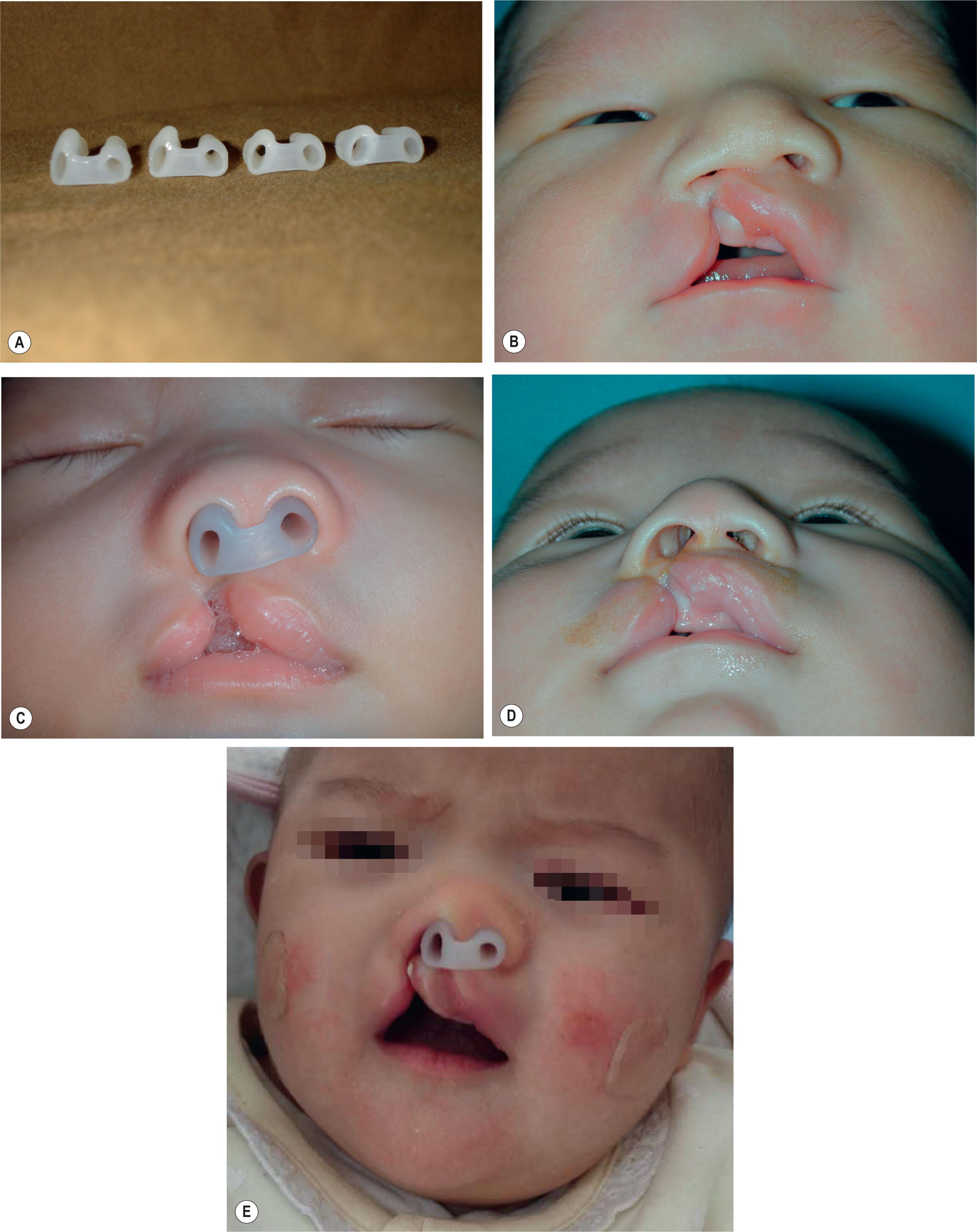
Nasoalveolar molding has a poor effect on patients with complete cleft of the primary palate. The protruding premaxilla is very difficult to be pushed backward by the NAM device as there is no cleft behind the alveolar process. There is little room for the nasal mold due to the protruding premaxilla. The senior author found that nasal conformers work better than the NAM device in this particular situation ( Fig. 19.2.3E ).
The senior author uses these surface anatomic points for surgical planning ( Fig. 19.2.4 ). For unification, the “left” means the cleft side and the “right” means the non-cleft side :
LS: labiale superius, midpoint of Cupid’s bow
CPHIR: crista philtri inferior, right side, peak of Cupid’s bow on non-cleft side
CPHIL: crista philtri inferior, left side, peak of Cupid’s bow on cleft margin of the non-cleft side
CPHIL′: crista philtri inferior, left, peak of Cupid’s bow on cleft side lateral lip
CHR: cheilion, right side, commissure on non-cleft side
CHL: cheilion, left side, commissure on cleft side
SN: subnasale, midpoint of columella
CPHSR: crista philtri superior, right side, upper point of philtral column on non-cleft side
CPHSL: crista philtri superior, left side, upper point of philtral column on cleft side
CPHSL′: the new crista philtri superior, left side, after Mohler’s rotation incision
MNSR: medial nasal sill point on non-cleft side
MNSL: medial nasal sill point on cleft side
SNLG: the split point of nasolabial groove: the point in nasal vestibulum where the skin-mucosal junction changes its direction
SBALR: subalare right, the most inferior point of the alar base on the non-cleft side
SBALL: subalare left, the most inferior point of alar base on the cleft side
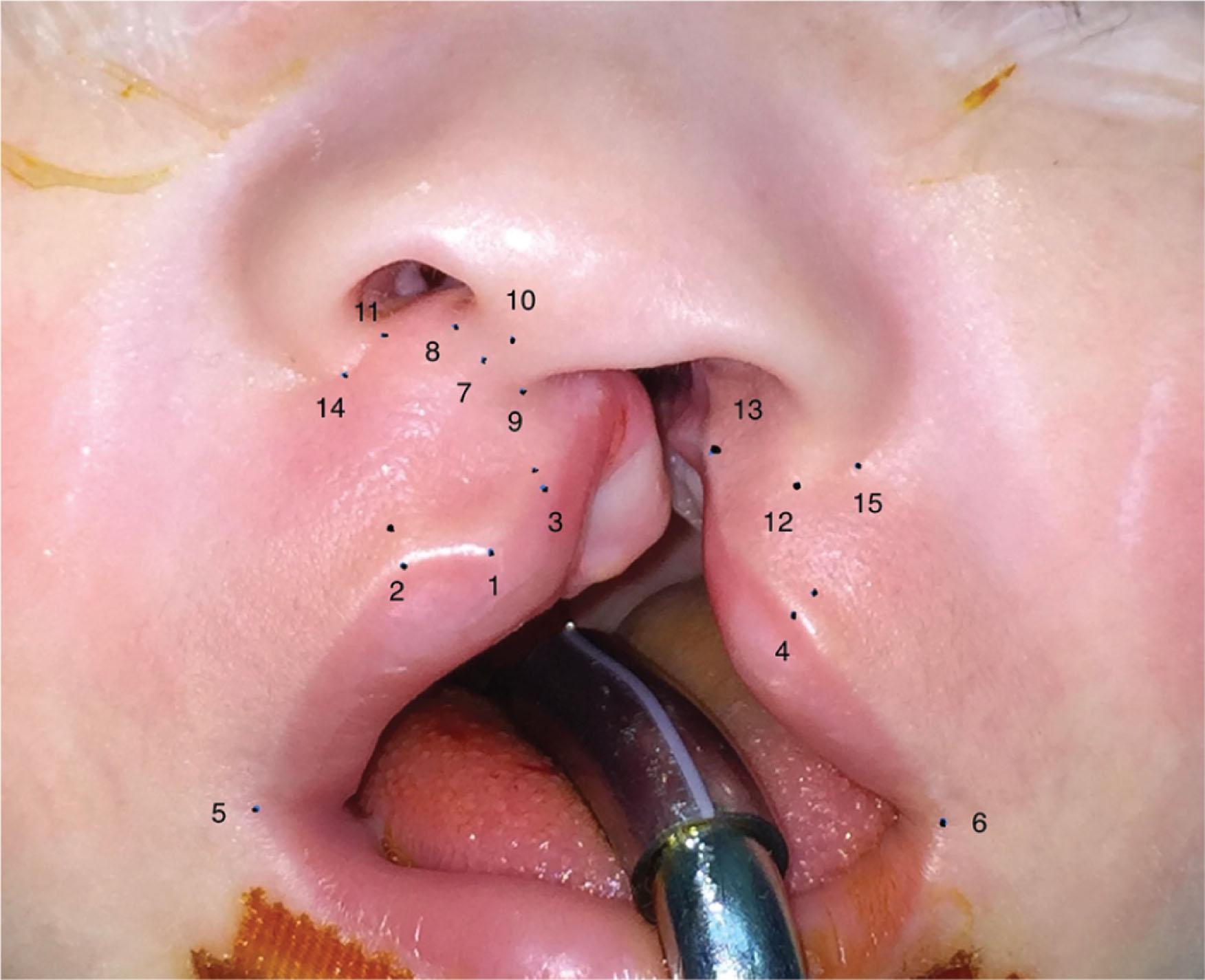
The points of the Cupid’s bow (CPHIR, LS, CPHIL) are marked on the epidermis–vermilion junction line along with the white skin roll (WSR) as described by Millard. Usually, point CPHIR is the easiest point to identify. Gentle upward lift on the nasal tip with a finger helps to define point LS ( Fig. 19.2.5 ). This is essential because it is easier to level the Cupid’s bow if LS is marked toward CPHIR, making Cupid’s bow somewhat narrower. However, the shape of the Cupid’s bow can be partially deformed by moving the LS toward CPHIR. If one places point LS toward the cleft margin, point CPHIL will be moved higher, and it will be more difficult to level the Cupid’s bow. The distance between LS and CPHIL is determined by the measurement between CPHIR and LS. The vermilion–mucosa junction line, namely the red line, is also marked. This clearly defines the intervening vermilion below the level of the Cupid’s bow. It also identifies the vermilion deficiency beneath the level of the Cupid’s bow near the cleft margin. The next points to be marked are the midpoint of the columellar base (SN), the highest points of the philtral columns (CPHSR, CPHSL) and the commissures (CHR, CHL). Point CPHSL′ is located in the columella. It is the new highest point of the philtral column on the left side after the Mohler’s rotation incision. The distance between CPHSL′ and CPHIL should be equal to the distance between CPHSR and CPHIR. Lastly, the width of the white skin roll at point CPHIR is marked out. The width of the white skin roll is usually around 1.5–2 mm at the age of 3–6 months old ( Fig. 19.2.6 ).
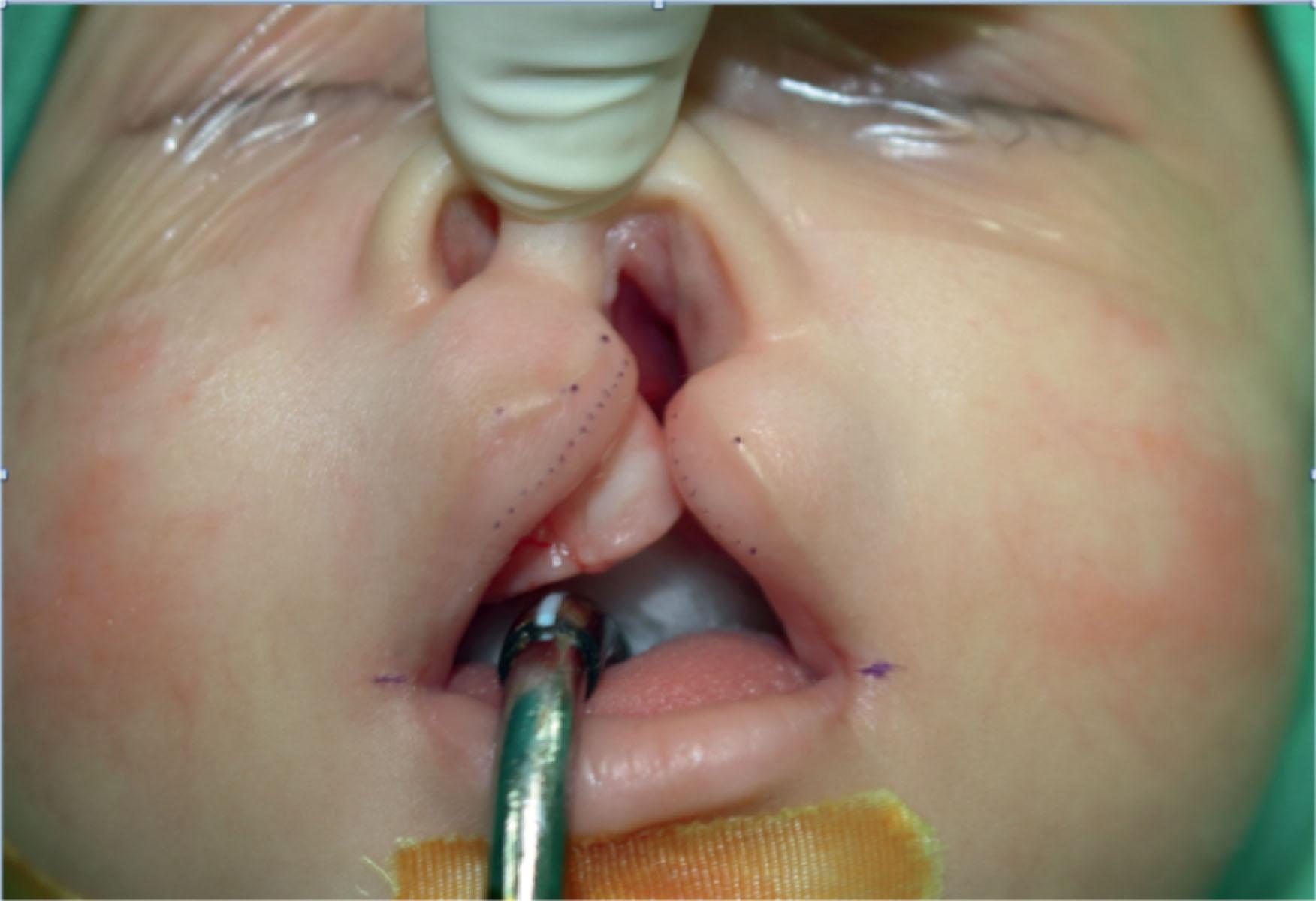
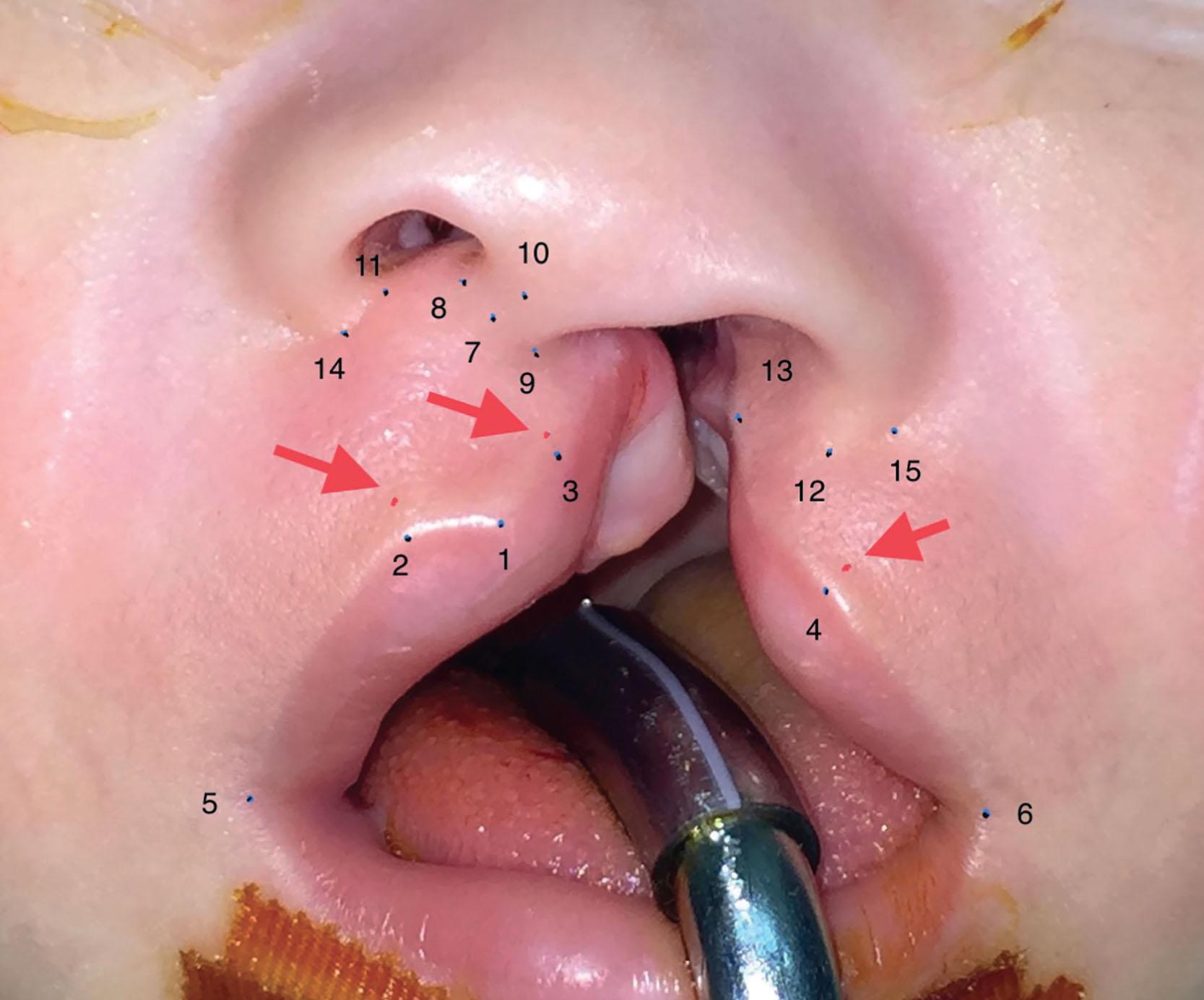
The peak of the Cupid’s bow on the cleft side (CPHIL′) is a definite anatomic point but somehow difficult to identify. The red line always converges and meets the white skin roll medially. CHPIL′ is where the WSR changes direction and the vermilion is at its widest point, usually 3–4 mm lateral to the converging point of the red line and the white skin roll. This is an important anatomic point for the cleft-side philtral column and the peak of the Cupid’s bow, and it seldom requires adjustment unless there is a severe discrepancy in the horizontal or vertical length ( Fig. 19.2.7 ). As mentioned earlier, the width of the white skin roll flap corresponds to the measurement on the non-cleft side. The split point of the nasolabial groove (SNLG, the point where the skin–mucosal junction changes its direction at the deepest point of the nasal vestibulum on the cleft side) is also marked.
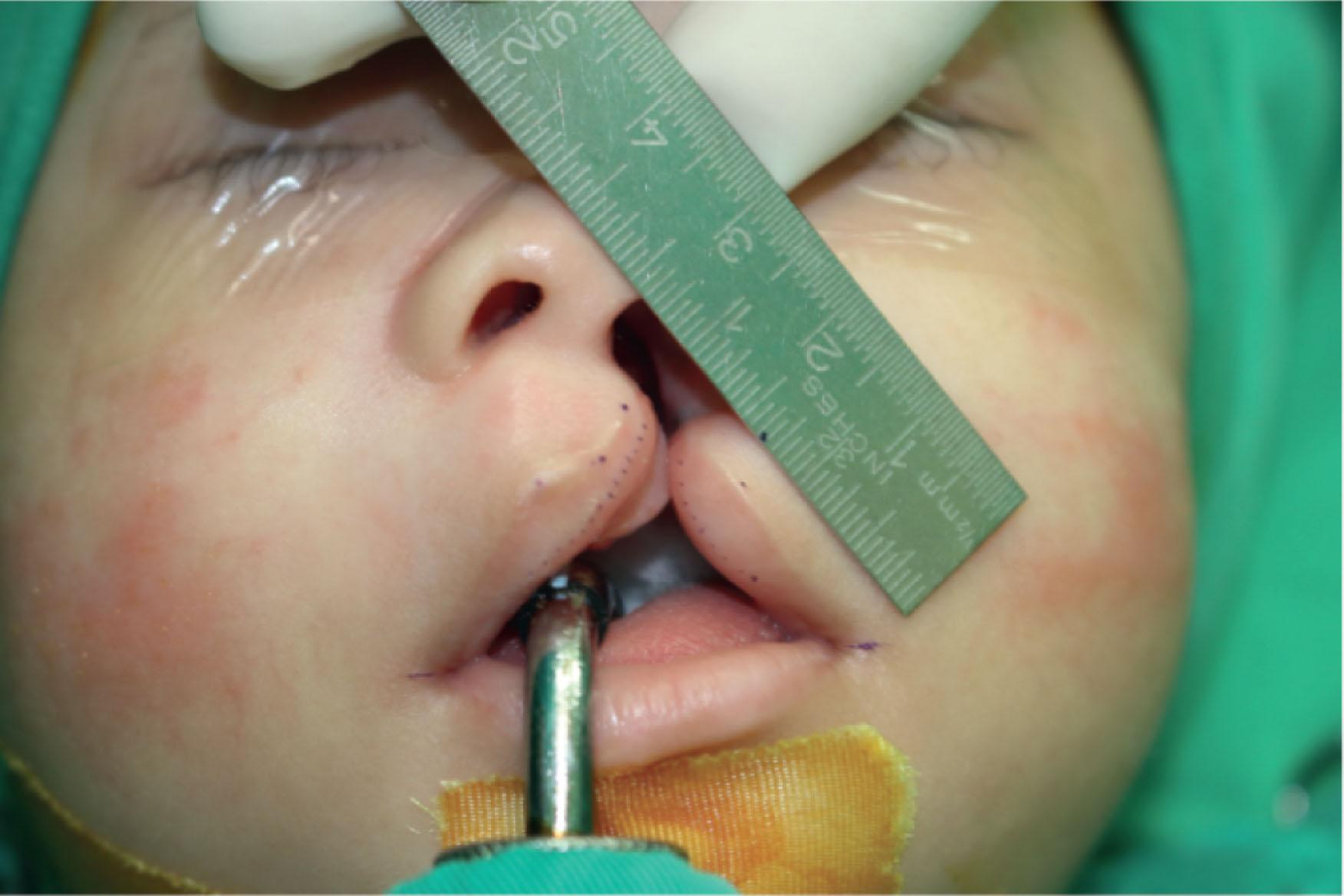
Gentle inward pressure on the cleft side alar base helps to define the position and direction of the cleft side nasal sill. The proposed point of the medial nasal sill, MNSL, is the point where the nasal sill ends medially and meets the base of the columella during skin closure. This point is marked accordingly to the point of the medial nasal sill on the non-cleft side, MNSR. It is usually 2 mm more lateral than MNSR. Point MNSL is approximately 5–6 mm from a tangential line on the alar-facial groove in a 3- to 6-month-old baby. This distance helps to achieve an overcorrected nostril width on the cleft side.
Various measurements are made, based on the anthropometric points marked ( Fig. 19.2.8 ). Important measurements for the surgeon to be evaluated, include the vertical height (5 A, 5B) and the horizontal length (6 A, 6B) of the lip.
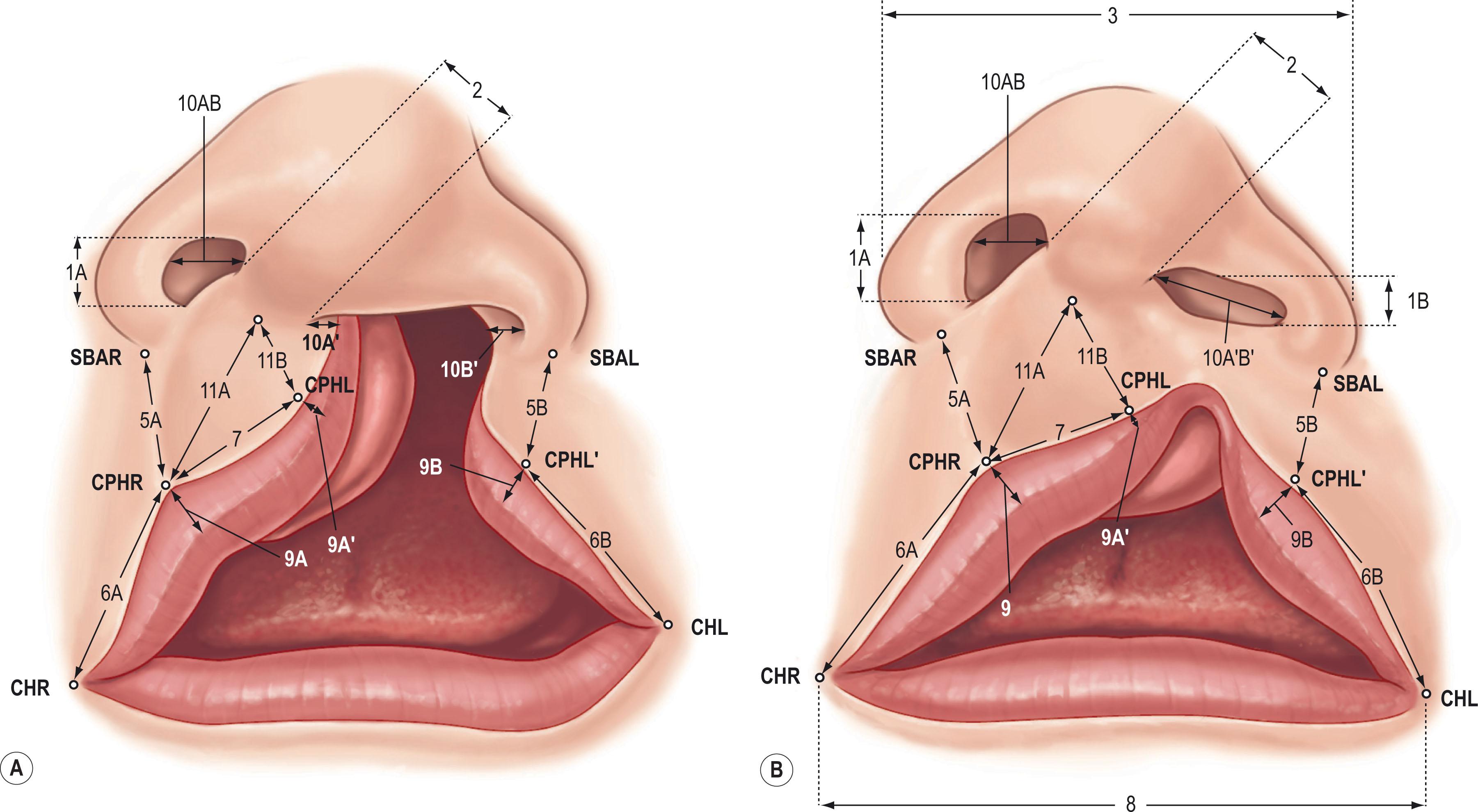
The discrepancy between the heights from the central columella base (SN) to the two peaks of the Cupid’s bow (CPHIR and CPHIL) is critical for leveling the Cupid’s bow. The authors favor Mohler’s incision for rotation if the discrepancy is over 2 mm. A shorter rotation incision from CPHIL to CPHSL is carried out if the discrepancy is less than 2 mm.
The short horizontal length on the cleft side (HL) can be lengthened by adjusting point CPHIL′ medially; however, this would shorten the vertical height (VL) ( Fig. 19.2.9 ). Vertical height is more aesthetically important than horizontal length. Therefore, vertical height is seldom sacrificed for horizontal length. A short vertical height can be increased by adjusting point CPHIL′ laterally but this would result in an even shorter horizontal length which is already present. The traditional method of extending the upper rotation-advancement incision around the alar base can also increase the short vertical length. However, this results in an unacceptable peri-alar scar and should be avoided whenever possible. Point CPHIL′ is as important as other anatomic points and should not be adjusted until all incisions, muscle dissection, and approximation are completed. This is because an increase in vertical height, up to 3–4 mm, can be achieved by adequate muscle dissection and skin redraping over the muscle, thus eliminating the need of peri-alar incision or CPHIL′adjustment. This lengthening effect should be taken into consideration rather than strictly observing the mathematically fixed points marked before lip incision. The preoperative measurements between points will differ after muscle release, muscle approximation, and skin redraping; therefore, they must be measured again after muscle approximation.
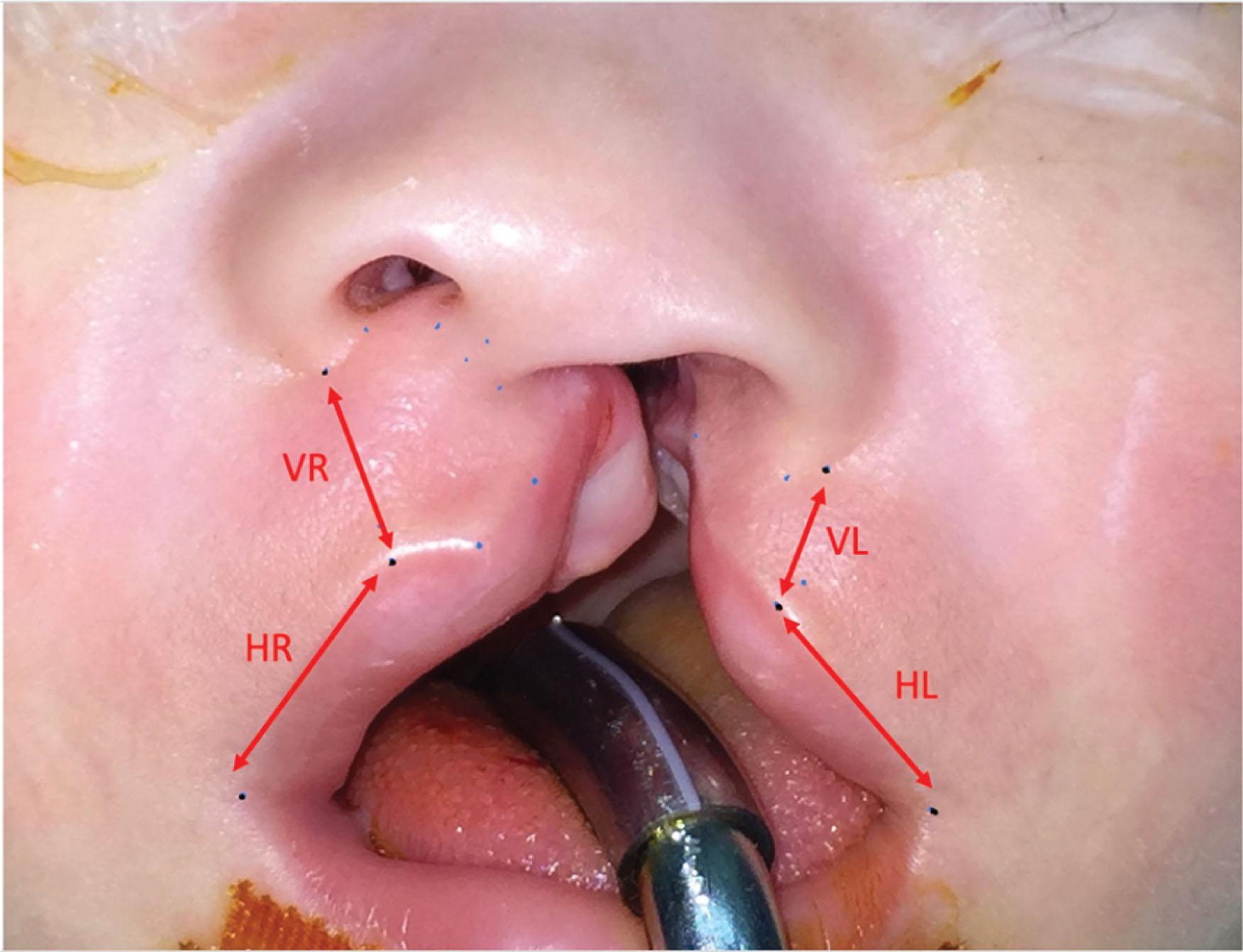
Incomplete clefts often appear to have a vertically long lateral lip. However, the cleft side vertical height is usually similar to the non-cleft side because the cleft side lateral lip and the alar base are inferiorly displaced. Therefore, the vertically long lateral lip, seen in incomplete clefts, is just an illusion. Adequate mobilization of the cleft side alar base and lateral lip, prior to advancing the entire lateral complex superiorly and medially, always levels Cupid’s bow without vertically shortening the lateral lip ( Fig. 19.2.10 ).

The white skin roll is usually at its widest above point CPHIR. It remains quite prominent between points CPHIR and LS but become narrower toward point CPHIL. The senior author routinely measures the width of the white skin roll at point CPHIR and transfers this measurement to the cleft side. The measured white skin roll at point CPHIR is usually wider (e.g., 1.5–2 mm wide at the age of 3–6 months old) than the observed WSR at point CPHIL′. A triangular white skin roll flap is designed above point CPHIL′. This 1.5–2 mm white skin roll flap helps to level the Cupid’s bow and corrects the white skin roll deficiency at point CPHIL. In addition, it helps reconstruct the upper lip contour line in accordance with the subunit concept as advocated by Onizuka ( Fig. 19.2.11 ).
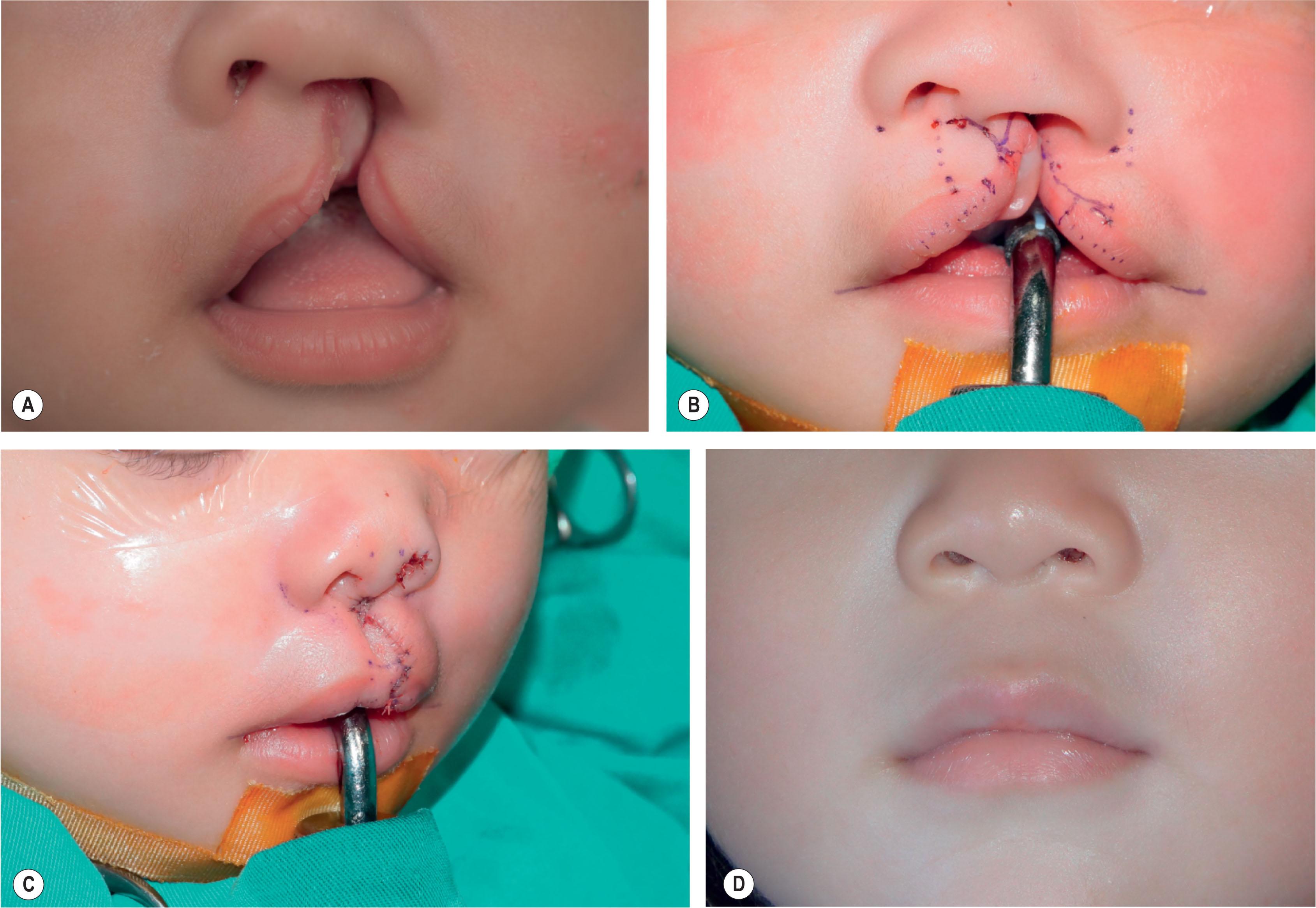
The vermilion width beneath point CPHIL is always deficient compared with the counterpart vermilion at point CPHIR or CPHIL′. Inadequate reconstruction of this vermilion deficiency will result in free border deformities like exposed mucosa, color mismatching, and dry crusting as seen in a straight-line vermilion closure ( Fig. 19.2.12 ). Therefore, the vermilion medial to point CPHIL′ should be used to correct the vermilion deficiency beneath the point CPHIL.
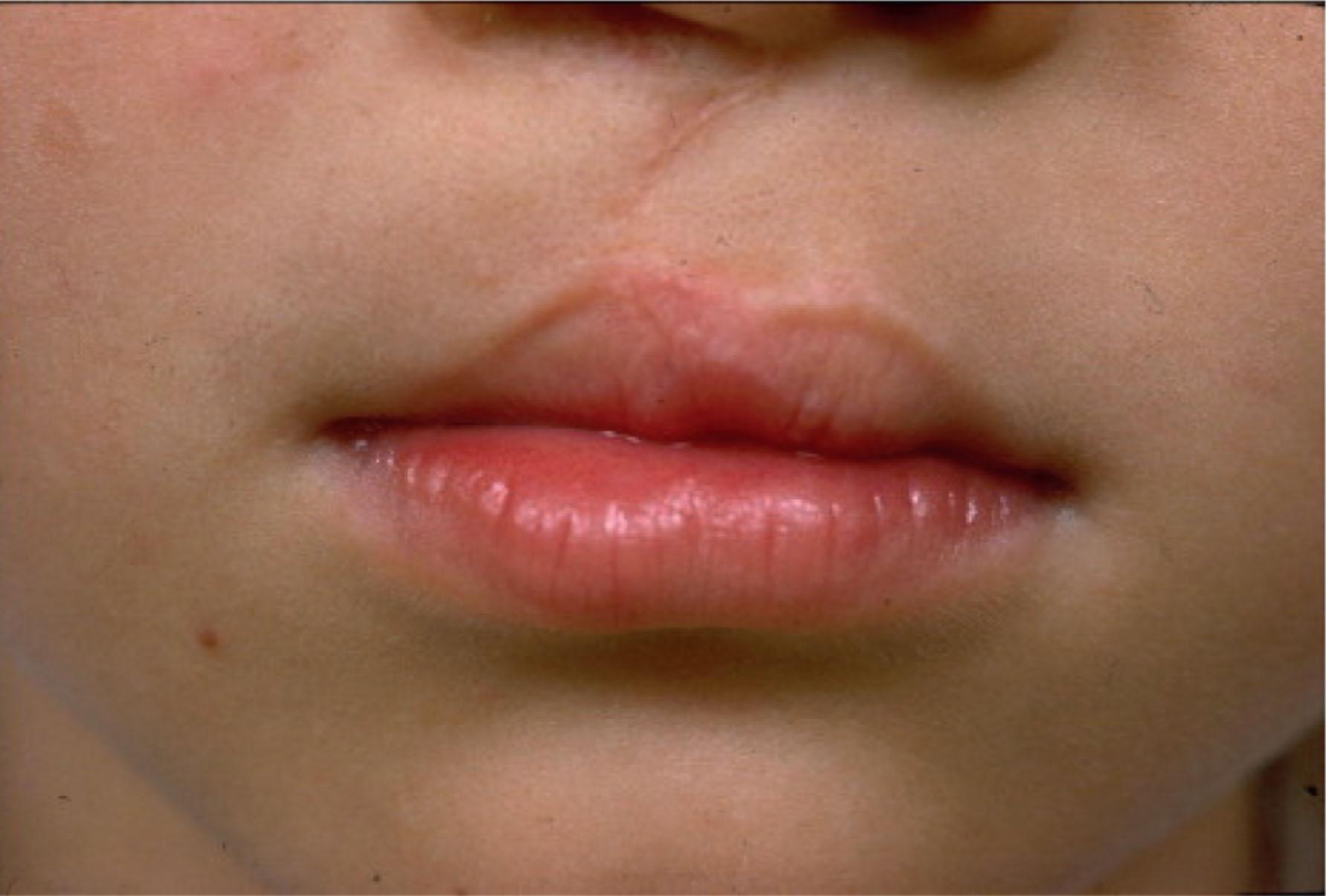
The senior author uses two kinds of incision on the non-cleft side: (1) Mohler’s incision if the discrepancy between CPHSR–CPHIR and CPHSL–CPHIL is more than 2 mm ( Fig. 19.2.13 ) and (2) simple rotation incision if the discrepancy between the two sides is less than 2 mm ( Fig. 19.2.14 ).
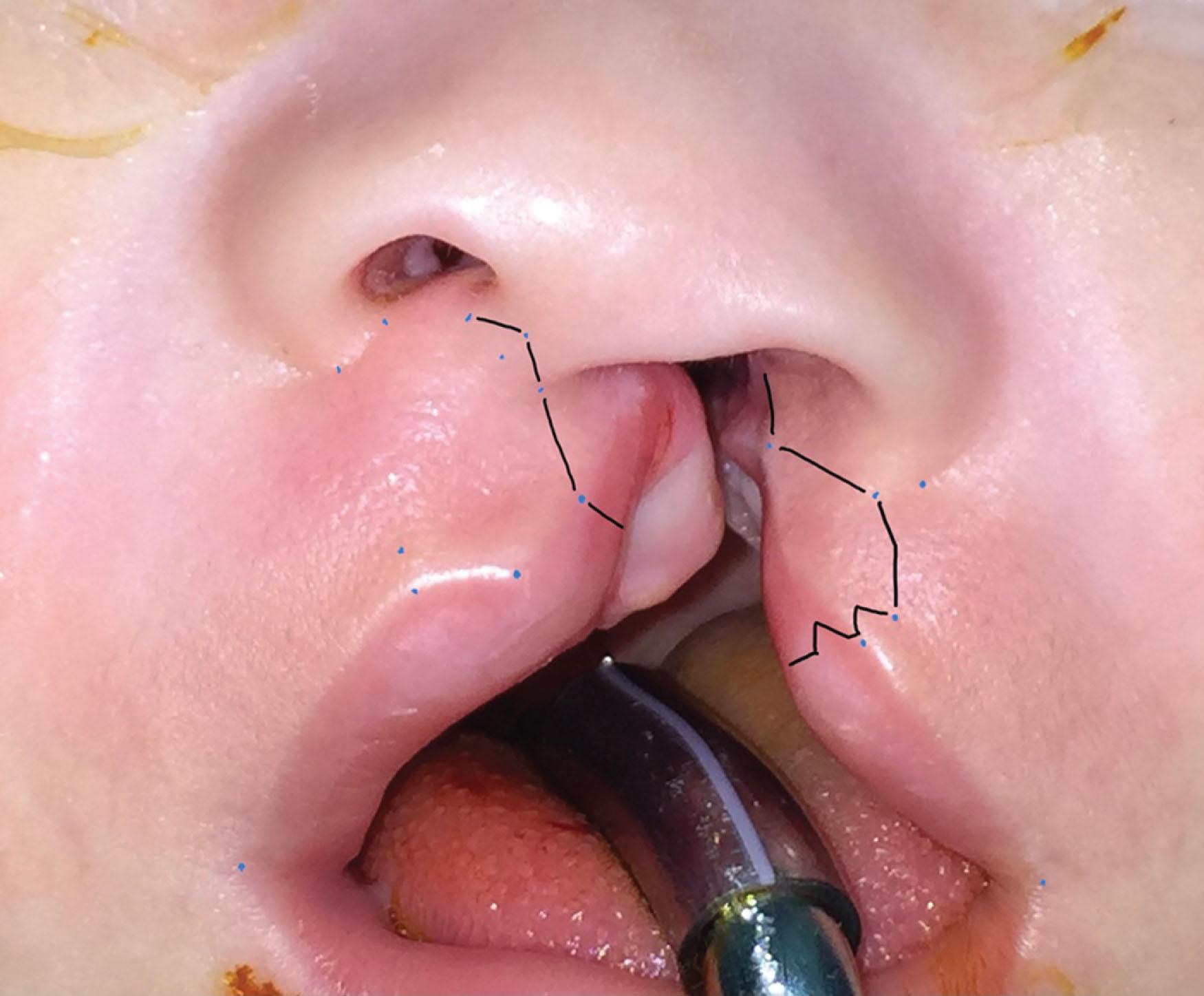
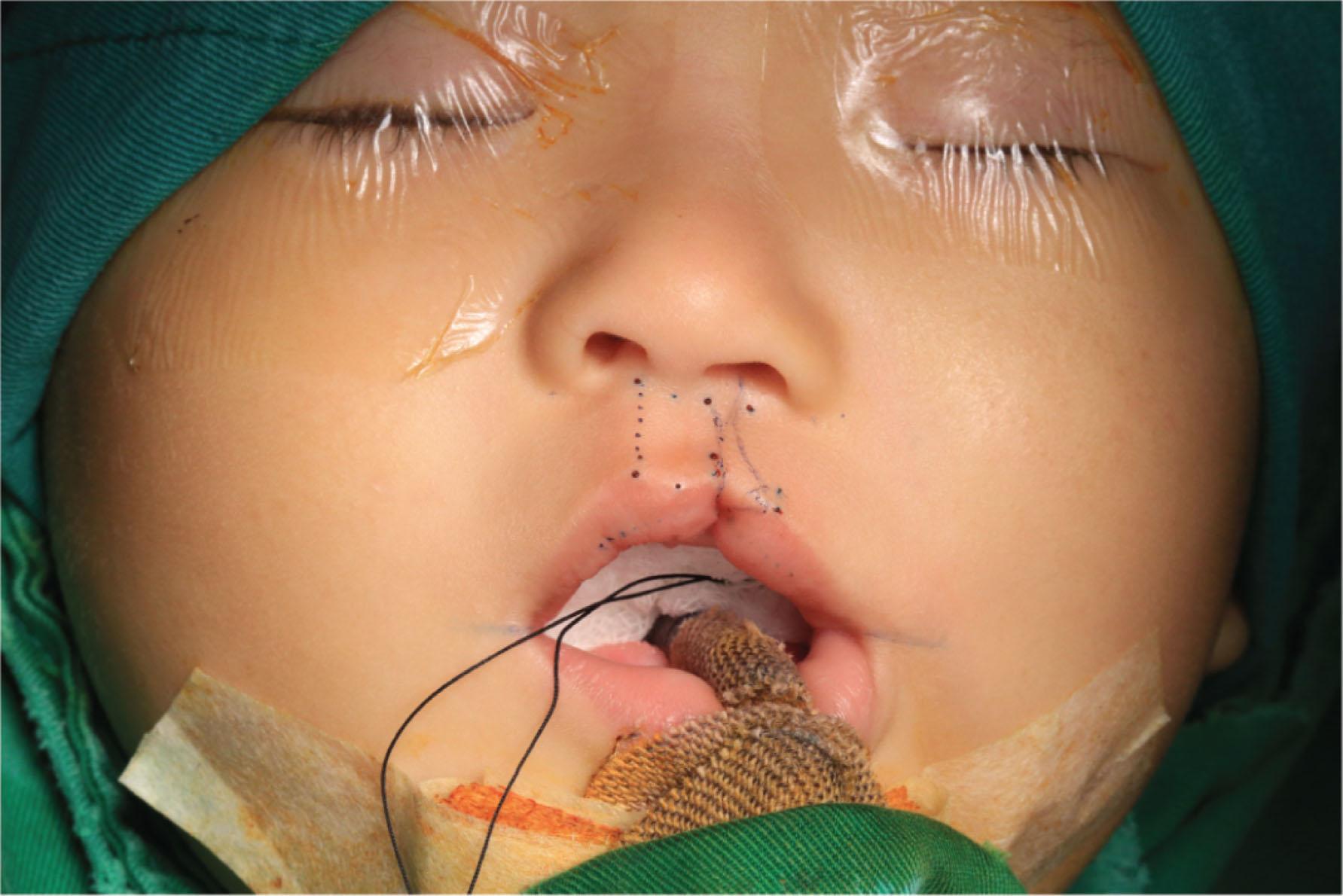
The incision is marked as a curvilinear line from CPHIL to CPHSL, extending upward to the point CPHSL′ and then back to the point CPHSR ( Fig. 19.2.13 ). The distance between CPHSL′ and CPHIL should match the height of the non-cleft side philtral column, e.g., CPHSR–CPHIR ( Fig. 19.2.15 ). The angle of the back-cut depends on the width of the columella, and it should ideally be around 90° ( Fig. 19.2.15 ). If the columella is narrow, e.g., in the presence of median facial dysplasia, a Mohler’s rotation incision would result in a very narrow columella base and should be avoided.
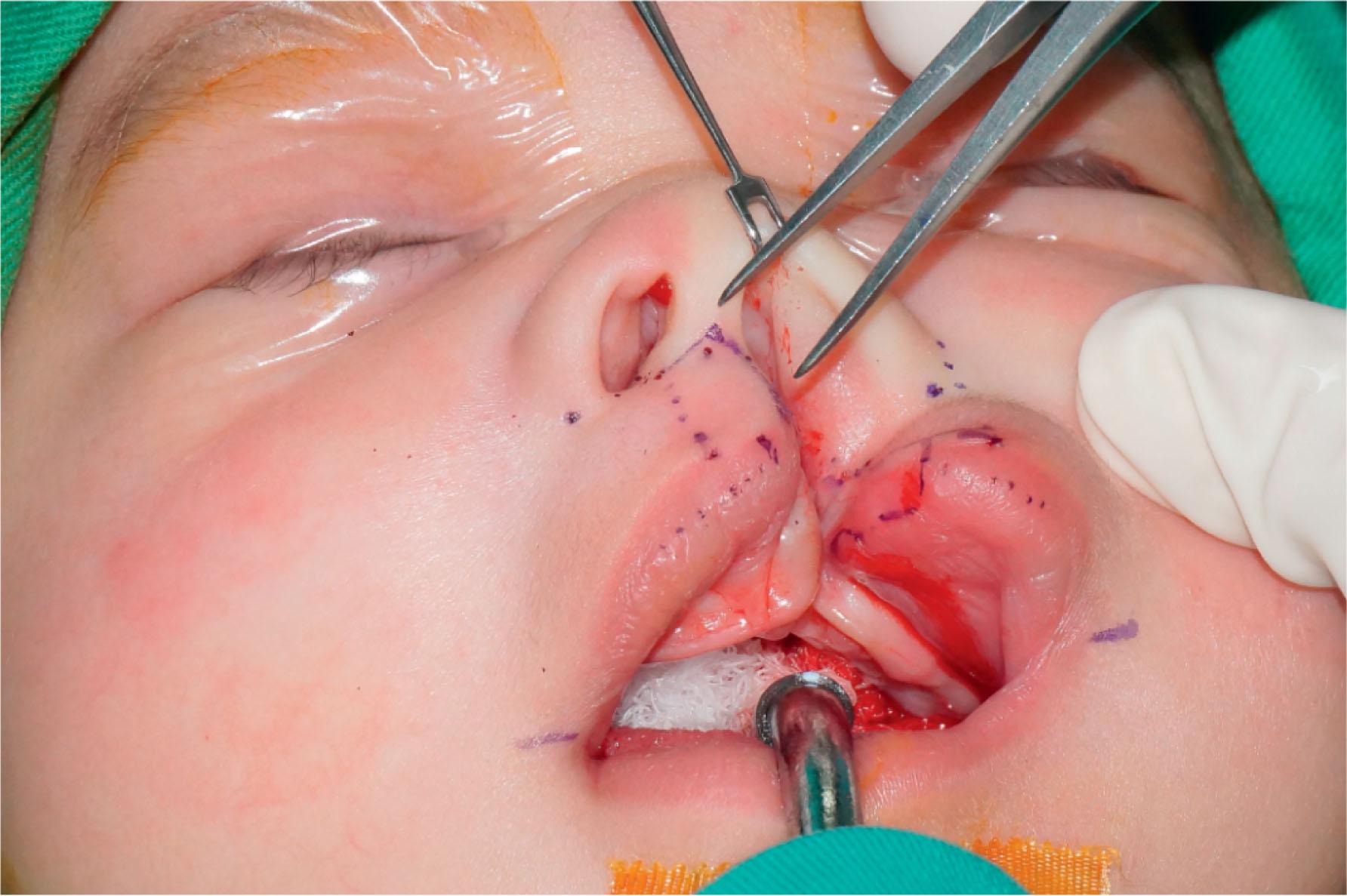
The incision across the free border of the lip at CPHIL should be made at a right-angle with the axis of the white skin roll, to include more tissue at the free border and facilitate subsequent lip closure (see Fig. 19.2.13 ). The incision should never cross point CPHSR as this will lengthen the lip on the non-cleft side.
If the philtral height discrepancy is less than 2 mm, a simple rotation can be made from CPHSL to CPHIL (see Fig. 19.2.14 ). The advantage of this simple rotation incision is to avoid the scar on nasolabial junction after a Mohler’s incision that is sometimes more evident than the vertical component of the lip scar. If the rotation is inadequate, the incision can be extended upward to CPHSL′ and then turned back to CPHSR, thus being converted into a Mohler’s incision.
Mohler and Onizuka analyzed the shape of the philtrum and concluded that, in most cases, philtral columns have an outward curvilinear configuration. Therefore, the senior author strongly sustains that the curvilinear incision of Mohler gives a better philtral morphology than other types of incision.
The lip is stabilized with hooks and fingers while incised with a No. 67 blade. After skin incision, the rotation flap is completed with a pair of tenotomy scissors. The abnormal muscle insertion to the columella base should be adequately released ( Fig. 19.2.16B ). Downward traction of the lip will determine if points CPHIR and CPHIL are at the same level ( Fig. 19.2.16C ). The back-cut advocated by Millard is not recommended, even if the rotation is not adequate, as this will leave a wider and lower defect at the apex of the rotation incision. Extension of the rotation incision beyond point CPHSR is not recommended either, as this will result in a vertically long lip. If the Cupid’s bow is not leveled after the rotation incision, no further action is needed to be taken until muscle dissection and approximation have been completed.
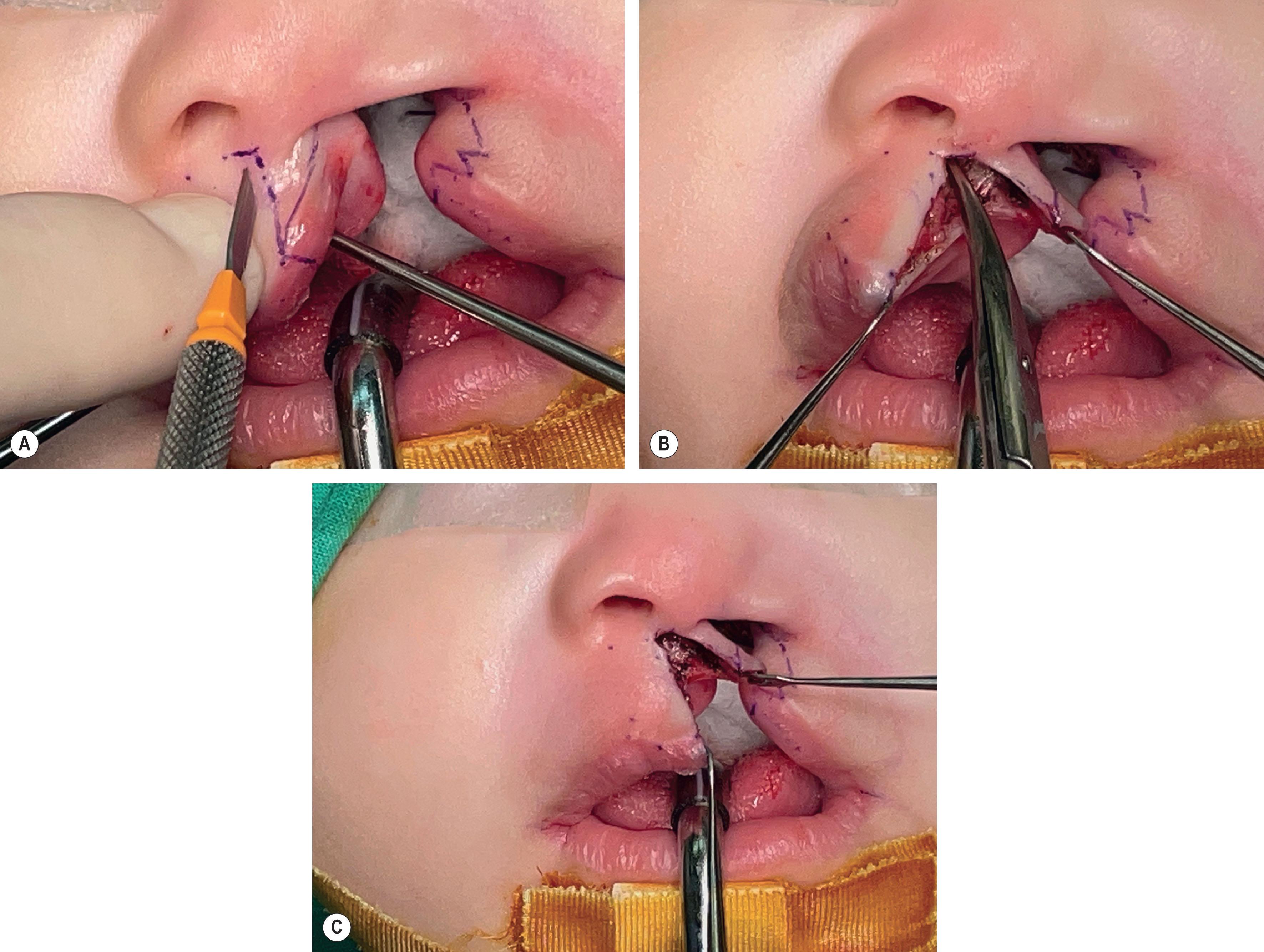
The senior author routinely inserts a white skin roll flap for lip subunit repair. This white skin roll flap provides an additional 1.5–2 mm of lip length, lowering and balancing the Cupid’s bow. This flap decreases the necessity of a back-cut.
The muscle layer is dissected along the skin edge initially with a blade, then continued with a pair of tenotomy scissors. The abnormal muscle insertion beneath the columellar base and nasal floor on the non-cleft side is released. Following this, the muscle attachment to the skin, in the subdermal plane, is released to the midline of the philtrum. The dissection plane is deeper initially, leaving a cuff of muscle on the incision edge for better philtral ridge morphology ( Fig. 19.2.17 ).
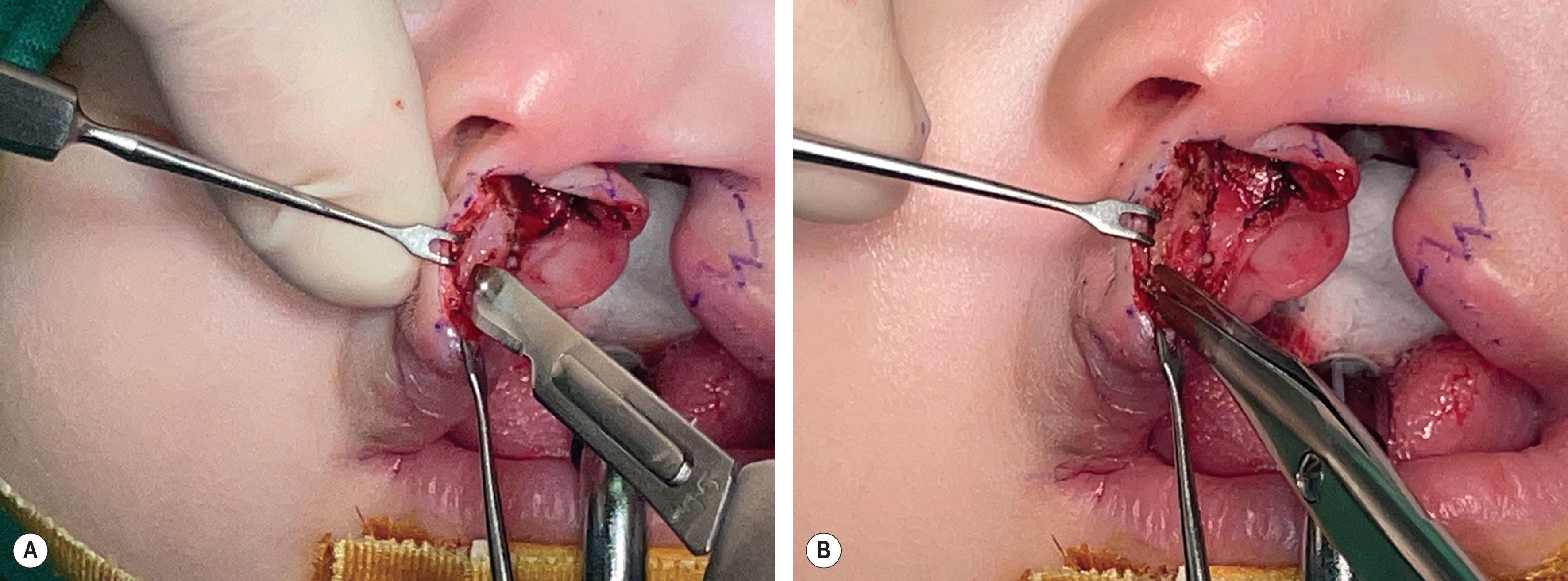
The C-flap incisions are made in the line extending from point CPHIL along the skin and vermilion–mucosa junction to the deepest point of the skin on the premaxilla ( Fig. 19.2.18A ). Then, the incision turns superiorly along the junction of the columellar skin and septal mucosa. The inter-crural space beneath the columella is separated by tenotomy scissors ( Fig. 19.2.18B ). This allows mobilization of the C-flap and repositioning of the downward displaced medial crura foot plate of the cleft side lower lateral cartilage. The medial tip of the C-flap (at point CPHIL) will be used to fill in the defect at the columellar base created by the Mohler’s incision. For patients with a simple rotation incision, it will be trimmed accordingly.
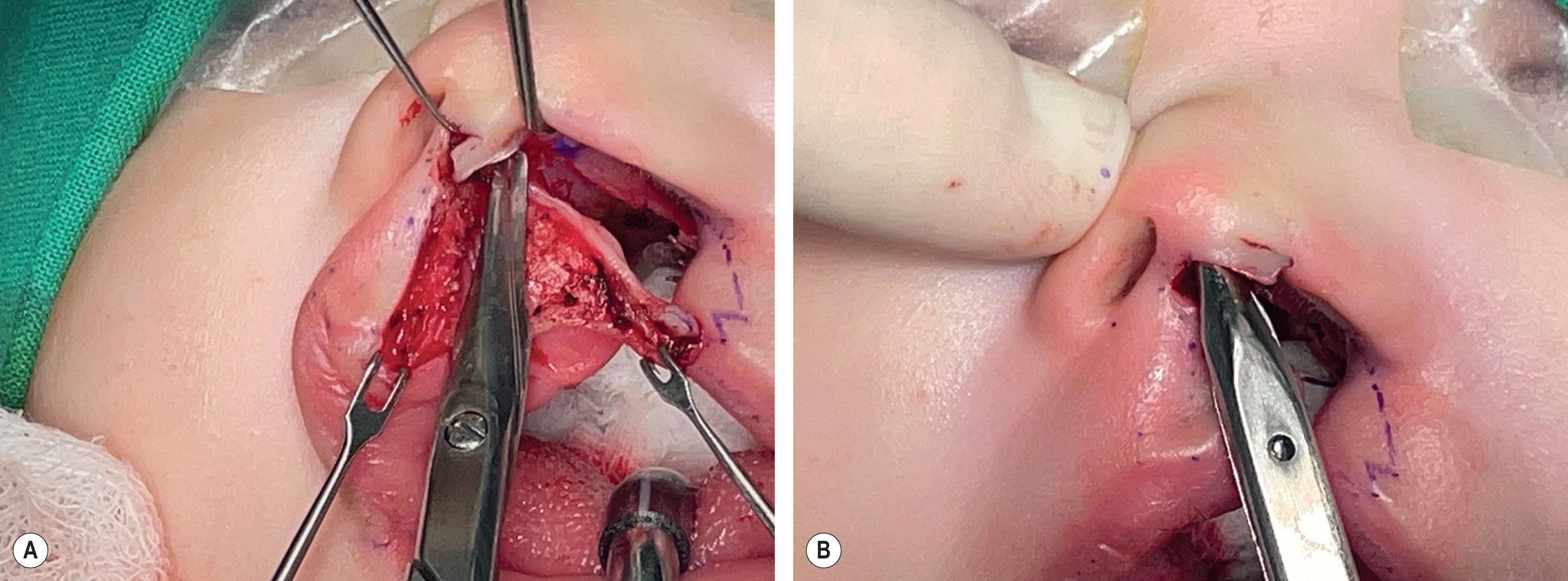
The senior author will repair the anterior palate during primary lip repair. The septal incision behind the C-flap is extended downward behind the premaxilla along the junction of the vomer and hard palate ( Fig. 19.2.19A ). A septal flap is raised in a subperichondrial plane in continuity with the vomer periosteal flap used for anterior palate repair ( Fig. 19.2.19B,C ). The caudal part of the cartilaginous septum is released from the vomer bone through this incision, allowing repositioning of the septum.
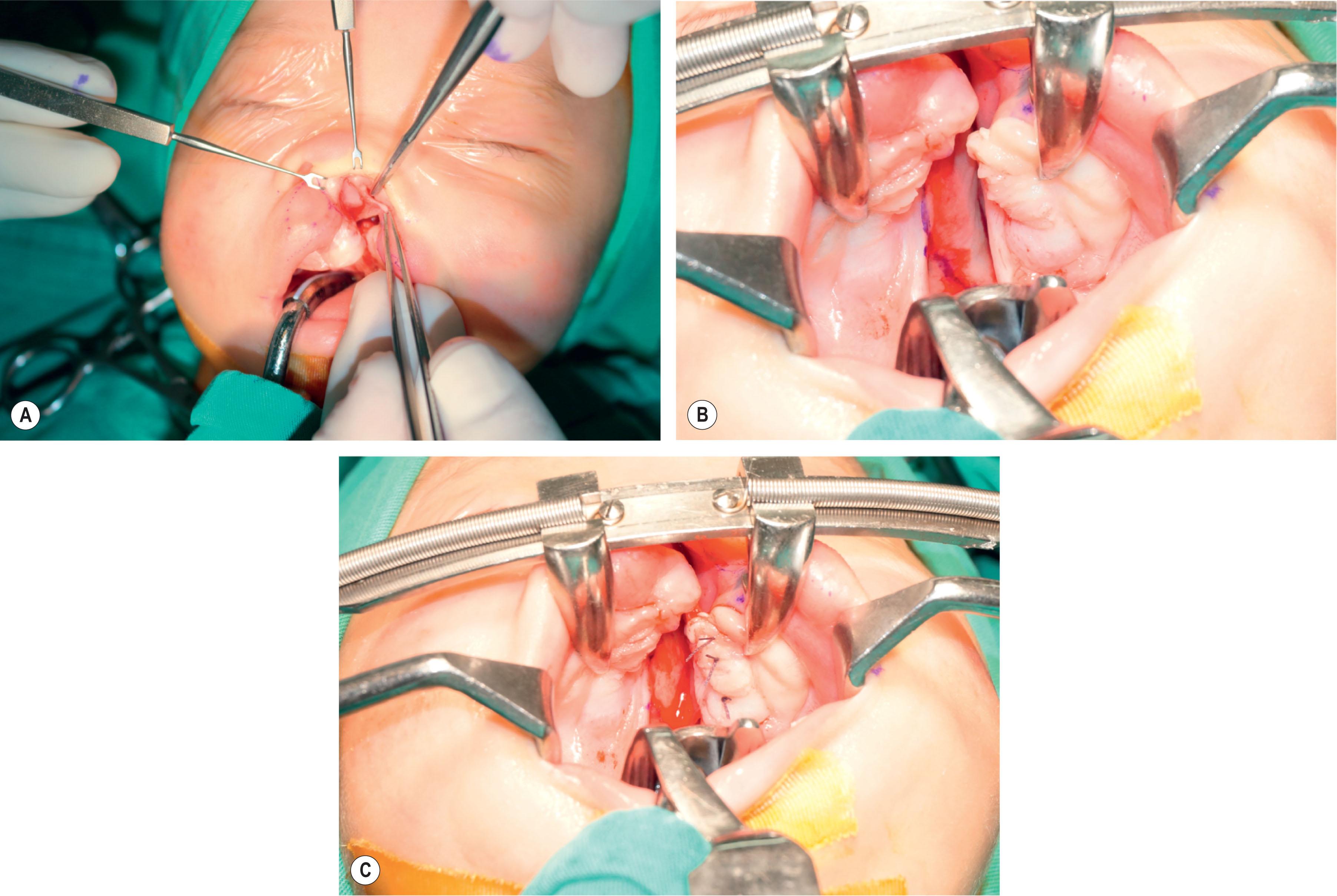
A triangular white skin roll flap is designed at point CPHIL′ according to the width of the white skin roll at point CPHIR (see Fig. 19.2.13 ). Usually, the width and length are around 1.5–2 mm in a 3- to 6-month-old baby. Then, a curvilinear incision is made connecting the upper point of the white skin roll flap and point MNSL. The incision is extended inward to point SNLG where the direction of the skin–mucosal junction changes and then upward along the piriform junction between nasal vestibular skin and mucosa, to the base of the inferior turbinate ( Fig. 19.2.20 ). The incision line below point CPHIL′ is moved downward for 1 mm, then medially to include 3–4 mm of vermilion, and finally at right-angles down to the mucosa (see Fig. 19.2.13 ).
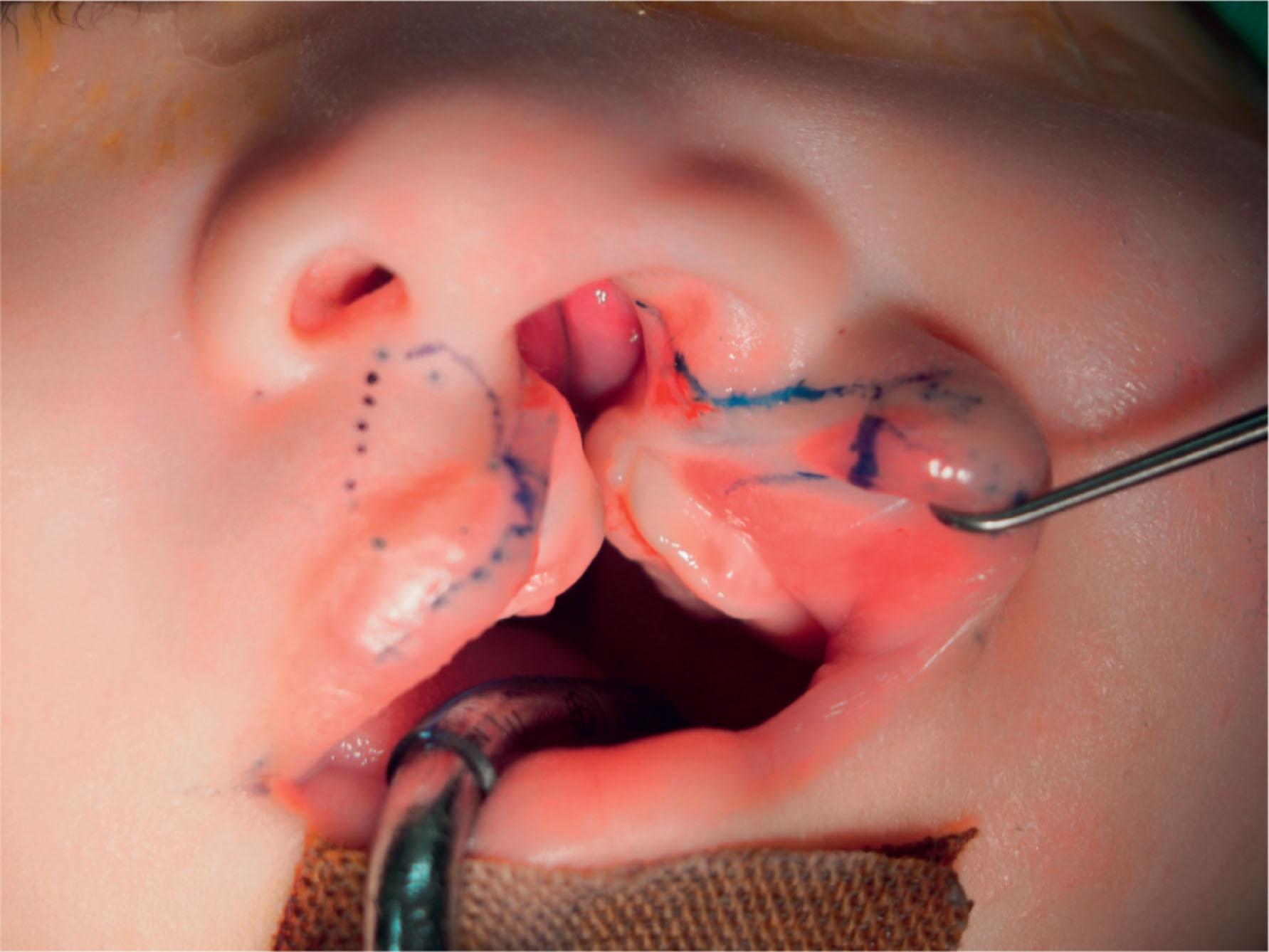
Become a Clinical Tree membership for Full access and enjoy Unlimited articles
If you are a member. Log in here